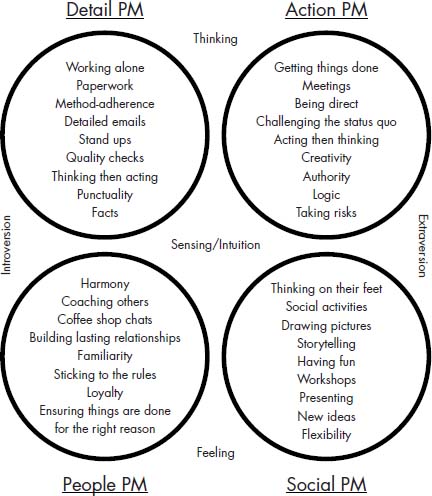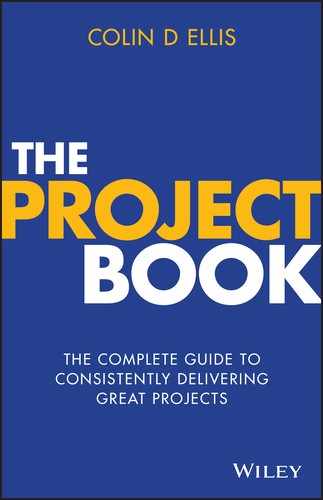CHAPTER 9
ADAPT YOUR STYLE TO FIT THE PROJECT
My very first interview for a project management role wasn’t about my attention to detail around planning and controlling a project — thankfully! I don’t recall talking at all about the ‘technical’ side of the job. The bulk of the conversation revolved around my personality and how I would use and change it to suit the situation.
This concept was quite new to me, and something I’d never thought of before. However, I would be leading major transformation projects while also managing a team of software developers, and the two, I was told, would need different approaches.
Fast forward 20 years and this is something that rarely, if ever, makes it into the project management textbooks, let alone interviews. It doesn’t often make it into blogs either, as we don’t appear to understand or admit that the project manager is the key determinant of whether or not a project succeeds.
The research tells us otherwise.
In 2007, Purcell and Hutchinson found a direct correlation between an individual’s personality and a successfully delivered project. A report in the Journal of Industrial Engineering and Management in 2014 confirmed that to be successful, project managers need to demonstrate extravert and perceiving personality traits (more about that soon).
Noted project management researcher Lynn Crawford argues that once a project manager has achieved an entry level of project management knowledge (yep, entry level), then more knowledge doesn’t make them more competent: ‘It’s their personality and leadership style that does’.
Conversely, every leadership and management blog or book you read will tell you that a strong personality and leadership are critical to organisational success. Barely a week goes by that we don’t happen on quotes from luminaries such as Drucker, Godin or Peters on just how vital it is.
So why the disparity between the two? Asked by the Project Management Institute in 2005 to research this, Turner and Muller couldn’t find a reason, concluding unsatisfactorily that ‘the question can only be answered if it’s directly measured’.
Thankfully, tools to perform this measurement now exist. Whether organisations consider measuring the leadership ability of project managers important, however, is another matter given how much easier it is to use the project metrics of time, cost and scope. Consultants will be hired to tell you the problem is your framework or templates, and will create months of work for themselves, only for nothing to change.
Of course, no one personality can successfully deliver all projects. What the research tells us is that different projects require different personalities and few organisations match these up well. Typically, whoever isn’t massively overworked at that time is given a project and (despite people like me delivering governance training that recommends otherwise) few project sponsors pick their project managers.
All research, blogs and personality ‘measurement’ tools link back to the work that Carl Jung did on personality back in the 1920s. Jung identified four functions of consciousness (sensing, intuition, thinking and feeling) and two attitudes (extroversion and introversion). These functions and attitudes combine to create four types of personality.
It’s important here to point out that any kind of personality profiling or testing can never be definitive, despite how it may be ‘sold’ to you. We are complex human beings and encounter different combinations of emotions and situations every day. So our personality will be made up of each of the four types in a mix that may change from day to day. Having said that, our DNA is hardwired towards a particular personality type, which makes us recognisable to others. It’s what others talk about (over our skills) when they speak of us.
This is how the four personality types fit in the project management world. They’re presented in circles because no one can put you into a box!

- Detail project managers like to work alone or in quieter environments. They take the time to think before speaking, focus on quality and require facts and data before making decisions. They are reserved and speak softly.
- People project managers put time and effort into building relationships. They are fiercely loyal and take the time to understand ‘why?’ so they can explain it to others. They’re warm and friendly, like harmony and do empathy really well.
- Action project managers just want to get things done and will get frustrated if things get in the way of that. They like logic, take risks and approach everything they do with an air of formality. Their language and communication are direct!
- Social project managers like to be in front of the room! They are flexible and creative, like to have fun and are always looking for better ways to do things. They are positive in outlook and will draw pictures with their hands or with pens!
Different personalities are best suited to different projects. For larger projects (in terms of both team size and organisational scope), an extravert may be best suited to the role, someone who can build key stakeholder relationships early and take the necessary steps to build a culture that will evolve and grow as the project progresses.
These people will be comfortable speaking to large groups of people, radiating their passion for the project. They know when to consult and when to direct, and ensure that senior management actions and behaviours are in line with the required outcomes. The author Beatrix Potter once said, ‘I hold that a strongly marked personality can influence descendants for generations’.
Introverts may be more suited to smaller, more localised projects. Relationship building is still key, along with the evolution of the project culture, but the groups will likely be more specialised and the stakeholder group smaller.
These people will have a greater subject matter knowledge, will focus on more collaborative activities and will favour faster delivery with less organisational impact. As Susan Cain says in her book Quiet: The Power of Introverts in a World That Can’t Stop Talking, ‘Introverts prefer to work independently and solitude can be a catalyst for innovation’.
That said, there are no hard and fast rules as to which personality type is ‘better’ or more effective. Both introverted and extroverted project leaders will need to adapt their behaviour and personality to the situation.
And there’s the rub. Project leaders have to know how to do all of the personality types and to adapt their style based on the situation they’re in. (This is easily the most popular part of my project leadership academy and also the most challenging thing for people to change.) Because whatever your predominant style, at various stages of your project you’ll need to be empathetic, kind and considerate and to role model leadership behaviour. You’ll need to put time and effort into maintaining plans, managing risks, dealing with issues and reporting on progress, and should always be able to answer the question ‘what’s left to do?’
Being a project leader is a never-ending personal development journey, and to grow and be successful you need to draw on all personality types.
